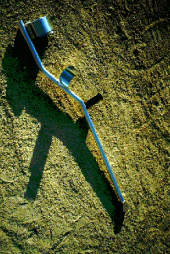Team Members: Roderick Bryce, Karl Richter
Supervisor: Professor Stuart McGill
Background
Standard axillary crutches, more commonly referred to as wooden crutches, have been in existence for thousands of years. Since 2830 B.C., the crutch has been characterized by a rigid supporting staff with an underarm crosspiece. The current design of the wooden axillary crutch has remained virtually unchanged for the better part of this century.
Axillary crutches fit under the armpit, or axilla, and provide stability with a pad held between the chest wall and upper arms. The lever arm, located between the axilla and the hand, enables enough force to be generated to permit walking when either leg is non-functional. The main disadvantage with axillary crutches is that the axilla region is not ideal for weight bearing. Thousands of people suffer from the problems that arise due to standard axillary crutch usage. The main problems associated with the axillary crutch design can be summarized into the following three points:
-
Axillary crutch usage causes an extreme amount of discomfort
-
Axillary crutches poorly distribute ambulatory forces on the user's body
-
The physical work required for ambulation is poorly distributed amongst the user's muscles
Our objective is to address the above mentioned problem areas and to design an improved crutch for individuals who are forced to use standard axillary crutches due to a single leg injuries.
Project description
The SYDE 461/462 workshop is a continuation from a third year design project (SYDE 361), named SYDE Arms. The SYDE Arms crutch removed the axillary pad and implemented upper and forearm braces to provide leverage for a three-point swing through gait. The SYDE Arms prototype crutch is shown in Figure 1. This workshop will provide an opportunity for continued research, design, prototyping and testing of an improved crutch design.
Specific design considerations are to incorporate the benefits associated with both the standard axillary crutch and the SYDE Arms crutch. To achieve this goal it is desirable to find a balance between the level of comfort provided by the SYDE Arms design and the reduced muscle activation associated with the standard axillary crutch. In comparison to the SYDE Arms crutch, an effort must be made to bring the crutch closer to the body in the lateral direction. This should reduce the muscular effort required to lift the body during ambulation and transmit more of the user’s weight directly downward through the crutch. Overall this should lead to a reduction in fatigue. Lastly, it is desirable, to reduce the amount of force transmitted to the axilla region by relocating a portion of that force to the outer upper arm. This will increase the level of comfort experienced by users.
To achieve these goals the new design will have both bracing as well as a removable axillary pad. The user will have the ability to use either the braces or the axillary pad alone, or a combination thereof. The highly adjustable brace system will allow the user to distribute the forces required during ambulation between various muscles involved as the users sees fit. A conceptual sketch of the new design is shown in Figure 2.


Figure 1 – SYDE Arms Prototype Figure 2-Sketch of ErgoCrutch
Design methodology
The design methodology can be broken down into the following steps:
-
Market research and evaluation of current crutch designs and the SYDE Arms crutch
-
Development of criteria and constraints
-
Generation of feasible component solutions
-
Evaluation of component solutions using a criterion matrix
-
Detailed design and prototyping of final solution
-
User acceptance testing, EMG testing and evaluation of the force distribution on the user and the crutch
-
Assembly and component drawings
-
Development of manufacturing processes for components and final assembly